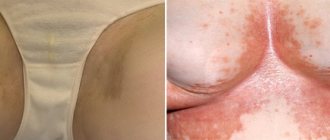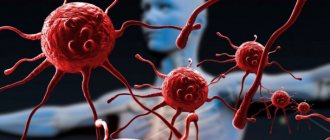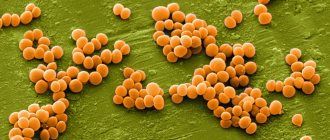Symptoms of rubella in children (photos), treatment and prevention
Rubella is an acute viral disease, detected in most cases in children 2–9 years old. Compared to other childhood infectious diseases, such as chickenpox and scarlet fever, it is uncommon. This is due to the fact that vaccination against rubella is included in the compulsory vaccination schedule in many countries of the world.
In unvaccinated children, the disease is mild and rarely accompanied by serious complications. It is most dangerous for pregnant women; its detection in the first trimester is a medical indication for termination of pregnancy.
What it is?
Rubella is a viral infection that spreads by airborne droplets mainly in children's groups. Despite its fairly mild course and rare cases of complications, rubella is considered a serious disease, and vaccination against it is included in the national vaccination schedule.
Historical facts:
- 1740 – F. Hoffman first described this infectious disease.
- 1881 - it was identified in a specific nosological form.
- 1938 – the viral nature of the disease was proven in Japan.
- 1941 - N. Gregg - described the symptoms of congenital rubella in children.
- 1961 – the causative agent of the disease was isolated.
An infected person becomes contagious (infectious) 7 days before the rash appears on the body and remains so for 2-3 weeks after the first signs of rubella appear. More often, the disease is recorded in cities with large crowds, as this creates a greater likelihood of contact with a sick person.
Sources
- Mayo Clinic. Rubella. 2021.
- Brenda L. Tesini. Rubella. MSD Handbook, 2021.
- FBUZ "Center for Hygienic Education of the Population" of Rospotrebnadzor. Rubella.
- Antipova A.Yu. Rubella virus and its teratogenic effect. Pathogenesis, clinical picture, diagnosis, prevention of congenital rubella syndrome // Infection and immunity. 2011. T. 1. No. 2. Page. 131–134.
- World Health Organization. Rubella. 2021.
- National Association of Healthcare Associated Infection Control Professionals. Rubella. Vaccination experts. 2021.
Routes of infection
A child can only become infected with rubella measles from an infected person.
The disease spreads through airborne droplets. The virus from the mucous membrane of the respiratory organs of an infected person enters the air. During inhalation, it is introduced into the body of a healthy child.
Your baby can get rubella if he has been in contact with:
- patients with an atypical form of the disease (with an uncharacteristic course of rubella, the rash and many other signs may be completely absent);
- infected people who exhibit all the characteristic symptoms;
- infants who are diagnosed with a congenital form of the disease (in such children, the virus can multiply in the body for 1.5 years).
The virus can be transmitted from an infected mother through the placenta to the fetus. The child develops congenital rubella. The pathogen has an extremely negative effect on the development of the fetus and can cause many developmental defects.
Medical observations show that the frequency of development of abnormalities in congenital rubella depends entirely on the period of pregnancy:
- 3-4 weeks – the probability of developing defects in a newborn is 60%;
- 9-12 weeks – deviations occur in 15% of infants;
- 13-16 weeks – malformations are diagnosed in 7% of newborns.
Features of rubella in children under one year of age
Rubella is extremely rare in children under one year of age. This is explained by the fact that most women, by the time they conceived, had either already had rubella in childhood or had been vaccinated against it. In this case, during intrauterine development and subsequent breastfeeding, the baby receives antibodies from the mother’s body to a variety of infections, including rubella, and for about a year his body is protected by the mother’s immunity.
If a woman did not have rubella before conception and was not vaccinated in childhood, then the chances of her unborn child getting rubella in utero or before the age of one year (before the scheduled vaccination) are high.
Rubella in infants is dangerous to health. It may be accompanied by convulsive syndrome, DIC syndrome (disseminated intravascular coagulation), the development of meningitis and encephalitis. A feature of the course of the disease at this age is its rapid development. Characteristic rashes can be present on the skin for no more than 2 hours, and then immediately disappear without leaving a trace. Children under one year of age who have had rubella develop a strong immunity to this disease, which means they no longer need to undergo routine vaccination.
Couple treatment of male infertility
Infertility in a married couple can be male, female or combined. But even dividing the problem in this way, you should not put the entire burden of treatment on one partner. The fight against infertility is always a mutual process, in which the psychological atmosphere in the family will play a huge role. The feeling of illness and of being “wrong” can cause a feeling of guilt in a family member and create additional stress, which will not have a favorable effect on preparing for the role of a parent. Particular attention should be paid to the situation of joint treatment of female and male infertility. In approximately a third of all cases of this diagnosis, the problem of infertility or simply reduced reproductive functions affects both partners.
The causes of the problem may lie in pathological disorders of the reproductive system of both women and men, which will entail specific diagnoses and treatment strategies, or they may have an unclear etiology, which will lead to a diagnosis of infertility of unknown origin. And as practice shows, even absolutely healthy men and women can actually have problems conceiving a child. According to statistics, such couples account for approximately 20% of couples with general infertility.
Each case of combinations of women's and men's health problems is quite unique, and therefore requires an individual approach and a responsible attitude on the part of the couple. Essentially, when treating female and male infertility, each person fine-tunes their own “reproductive mechanism,” but besides this, it is important to make sure that the partners tune in to each other. Spending time together in special medical sanatoriums can help with this.
First signs
In children in the initial stages of the disease, the first symptoms resemble a cold.
During the incubation period, rubella manifests itself as follows:
- weakness;
- The temperature with rubella increases (slightly);
- conjunctivitis;
- runny nose;
- pain in the throat;
- lymph nodes enlarge;
- the final symptom is the appearance of a rash.
Symptoms at the height of the disease are somewhat different. The virus has a toxic effect, which causes:
- Polyadenitis. The baby's lymph nodes become painful and enlarged: occipital, parotid, cervical.
- Fine-grained rash - round spots, localized on the skin surface, do not rise. Their size is approximately the same - 2-5 mm. They first appear on the neck and face, and after a few hours they cover the entire body. The rashes are abundant on the buttocks, back, and bends of the limbs.
- Catarrhal phenomena. Children exhibit cold symptoms.
- Mild intoxication. At elevated temperatures (not higher than 38 degrees), the baby feels unwell, headaches, and weakness.
Medicines
Photo: playbuzz.com
As is known, there is no etiotropic treatment; medications are prescribed to eliminate or alleviate the symptoms of the disease.
For a runny nose, vasoconstrictor nasal drops are used. Currently, the pharmacological market provides a lot of different drugs of this group, created for use among both adults and children. When vasoconstrictor drops enter the nasal mucosa, a spasm of the blood vessels located in it occurs. This leads to a reduction in swelling of the mucous membrane, which helps eliminate nasal congestion, reduce nasal secretion and improve nasal breathing.
Antitussives are prescribed to suppress the cough reflex. If there is a cough with viscous sputum that is difficult to separate, expectorants are indicated. According to the mechanism of action, there are 2 groups of expectorant drugs: one stimulates expectoration, the other dilutes sputum. In most cases, mucolytic agents are used, that is, those that thin out sputum, thereby facilitating expectoration. It is important to note that the simultaneous use of antitussives and expectorants is strictly prohibited!
To eliminate elevated body temperature, antipyretics are used. There are various forms of antipyretics: tablets, syrups, suppositories. This variety was created for ease of use among patients of different age groups. However, with rubella there is often a slight increase in body temperature, which does not require the use of antipyretic drugs. You should resort to their help when the temperature exceeds 38.0 °C.
Rubella symptoms
The virus has a toxic effect on small vessels located under the skin. As a result, a red rash forms on the surface of the child's skin. The severity of the symptoms depends entirely on the form of the disease.
Main symptoms and periods of the disease:
- Incubation period. Manifestations of rubella begin with the penetration of the virus into the body. They continue until a rash appears on the skin, when the virus penetrates the lymph nodes and multiplies rapidly there. Afterwards it spreads throughout the body in the blood. The first signs of rubella in a child: the temperature may rise, a headache may occur, and weakness may appear. The immune system, producing antibodies, begins to fight. The destruction of viruses in the bloodstream continues for one or two days, but during this period they spread throughout all organs and tissues. The incubation period ends when the viruses stop circulating in the blood, and on average lasts from 16 to 22 days, in some cases it can be shortened or increased (10-24 days). Clinical manifestations during this period are expressed in an increase in the occipital and cervical lymph nodes (also behind the ear). 5-8 days before the end of the incubation period, the baby begins to release viruses into the environment and becomes infectious.
- The height of the disease. A rash appears on the skin (mainly located on the ears and head). It represents round spots located at a distance. Their appearance occurs because antibodies are detected in the blood. The height of the disease lasts 1-3 days. Children are usually not bothered by anything other than weakness. The erased form proceeds without a rash. This disease can be diagnosed by performing a blood test for antibodies. The baby, even if he does not have a rash, is contagious all this time.
- Recovery. The virus still functions in the body, although the rash disappears. The period lasts 12-14 days. Afterwards recovery occurs. The baby is contagious for a week before the appearance of acne and the same amount after. He can attend kindergarten only after this period.
The disease acquired lasts for life.
Features of the rash
Even before the rash appears on the face and torso in children infected with rubella, one can observe bright pink specks in the mouth, which gradually merge into dark red spots.
Skin rashes begin to appear on the face, namely its lower part: in the ears, nasolabial area and on the cheeks. A day later, the rash begins to spread over the child’s body. The most pronounced spots of the rash appear on the buttocks, shoulders, elbows and knees. The approximate location of the rash on the body is shown in the photo below (under the letter “b”).
At the same time, the rashes are never localized in children in the groin, on the feet and palms, which distinguishes rubella from other diseases.
What rubella looks like, photo
Not all parents know how rubella manifests itself in children and often confuse this disease with a typical cold or acute respiratory infection. But it is necessary to carefully diagnose each such case and take measures to prevent complications of infection, which can affect brain structures, nerve fibers, spinal cord and connective tissue. The walls of small blood vessels are especially often affected.
Photo of rubella in a child:
Diagnostics
The primary diagnosis of rubella is based on medical history, epidemiological status in the locality, and the availability of information about outbreaks or episodic cases of infection in a particular preschool institution. A quarantine regime is immediately established in a kindergarten or nursery.
Upon examination, the doctor may see the presence of petechial rashes on the upper palate, larynx and pharynx. Enlarged occipital and cervical lymph nodes are palpable. During the period when there are no rashes, diagnosis can be carried out in the laboratory. To do this, blood is drawn from a vein. Based on the obtained biological material, a serological analysis is carried out, during which the titer of antibodies to the rubella virus is determined. The diagnosis can be established if the antibody titer exceeds the norm by 4 or more times. After the course of treatment, a repeat serological blood test is necessary.
Differentiation of rubella is carried out with the following diseases:
- adenoviral infection;
- measles;
- enterovirus infection;
- pityriasis rosea;
- Infectious mononucleosis;
- hives;
- erythema infectiosum.
Additionally, when diagnosing rubella, a general blood and urine test and an ECG are performed to exclude possible complications. X-ray of the lungs is prescribed if pneumonia is suspected as a complication of this infection.
Treatment of male infertility with hirudotherapy (leeches)
Among the non-traditional methods of treatment, it is worth noting the use of hirudotherapy for male infertility. Under the influence of leeches, blood circulation in the pelvic organs improves, erection and spermatogenesis improve, and congestive and inflammatory processes are eliminated.
Hirudotherapy for male infertility is used as an auxiliary treatment for certain forms of infertility. For example, if it is associated with the inflammatory process of the prostate gland. Hirudotherapy for male infertility can only be recommended by a doctor if he is confident in the effectiveness of this treatment method in your case. The same can be said about herbs for men against infertility, which can be prescribed by a doctor in complex therapy and are most often used in the form of dietary supplements for oligospermia. The effect of this treatment has not been proven.
Complications
Usually the disease in children is mild. Consequences from a previous illness are possible if the child’s immunity was weakened, or at the time of the illness another one was added to it. The disease is more difficult for unvaccinated children to tolerate.
Possible complications:
- angina;
- pneumonia;
- meningoencephalitis;
- otitis;
- arthritis;
- thrombocytopenic purpura (a decrease in the number of platelets in the blood is characterized by frequent bleeding, local hemorrhages on the skin);
- rubella encephalitis (inflammation of the membranes of the brain). The child recovers and is registered with a neurologist and infectious disease specialist for another 2 years (or maybe more). There is a possibility of death.
Congenital pathology has the following consequences:
- deafness;
- diabetes;
- encephalitis;
- bone damage;
- thrombocytopenic purpura;
- pneumonia;
- developmental delays;
- hepatolienal syndrome (enlarged liver and spleen);
- malformations of the eyes, heart defects.
How to treat rubella?
Uncomplicated rubella in children can be treated at home. Common activities include:
- Bed rest for 1 week.
- Isolation of the child for 3 weeks. This is the approximate period during which the patient releases the virus into the environment and can be dangerous to other children.
- Drink plenty of fluids. The daily volume of liquid is at least 2 liters. Some of the water must be replaced with mineral water without gas or Regidron.
- Frequent small meals. The diet is based on: fermented milk products, ground meat and fish, eggs and other foods high in protein.
Regarding drug therapy, there is no specific antiviral treatment for rubella. Drugs are prescribed to relieve symptoms and prevent complications:
- There is no need to lubricate the rash with anything. Antihistamines (Diazolin, Claritin, Fenistil, Tavegil, Suprastin, etc.) help reduce the intensity of rashes and itching.
- Antispasmodics and NSAIDs (No-Shpa, Children's Nurofen, Paracetamol) relieve headaches, body aches, and fever.
- Antibiotics are necessary if bacterial inflammation begins against the background of rubella - sore throat, pneumonia, lymphadenitis.
- Ascorutin at a dosage of 500 mg three times a day is taken to prevent disseminated intravascular coagulation syndrome.
Persistent fever, convulsions, signs of central nervous system damage are direct indications for emergency hospitalization of a child.
Causes of male infertility
Male infertility means the inability of a man to impregnate a woman. This problem can be discussed if a woman does not become pregnant within a year after the start of regular sexual activity without contraceptives.
Infertility in men can have various causes, but it is always based on three main factors:
- impaired viability or motility of sperm;
- significant decrease in sperm count;
- disruption of the passage of sperm through the vas deferens.
Congenital or acquired diseases can lead to such consequences. Thus, the most common causes of male infertility are:
- varicocele;
- testicular injuries, torsion;
- infectious diseases (infertility in men and mumps are closely related conditions; sexually transmitted infections can also lead to reproductive dysfunction);
- inflammatory diseases of the prostate gland, urethra;
- immunological and hormonal disorders;
- exposure to toxic substances: alcohol, drugs, certain medications.
First of all, a man should undergo the necessary tests to detect and confirm the fact of infertility. This can be done at a family planning center or a male infertility clinic. If you are interested in treatment in Moscow, then there will be no problems with this, since in any medical center there is a specialized doctor - andrologist. If there are no such clinics in your city, you can get tested for infertility by a urologist or andrologist at a local clinic.
Infectious mumps (mumps) as a cause of infertility
According to statistics, every fourth infertile man acquired this disease after suffering from infectious mumps, which is popularly called mumps. Infertility in men after mumps develops due to the fact that the mumps virus affects the gonads (testes in boys). A complication of mumps is manifested by orchitis (inflammation of the testicle), which also negatively affects the reproductive capabilities of men. It should be noted that mumps does not always affect the testicles; this only occurs with severe orchitis. Milder forms of mumps may have no effect on testicular development in future men!
Folk remedies
Popular methods of traditional treatment are:
- Lubrication of the rash. Rashes on the body cause itching in the baby. This reaction can be eliminated by lubricating problem areas with a (strong) soda solution. It is recommended to hold it on the surface of the skin for about 10 minutes. A weak solution of manganese will have a beneficial effect. The moistened napkin should be applied to the itchy area for about 10 minutes.
- Stimulation of immunity. Vitamin teas made from black currant, rose hips, and lingonberries can increase vitality and protective functions.
- Enrichment of children's body with vitamins. An infusion of rose hips, strawberries, and black currants is beneficial for the baby. Parsley, green onions, and dill should be included in the diet.
- Elimination of swelling of the lymph nodes. A cooling compress can help treat this condition. Use homemade cottage cheese. It has excellent anti-inflammatory properties. Place a 1 cm layer of cottage cheese on gauze. Secure this compress on the baby’s neck. Leave it on all night.
- Fighting fever. You can use an old remedy. If the temperature is high, place a damp, cool cloth on the baby's shins.
Prevention
A sick child is isolated for 5 days from the day of the rash. Children who have been in contact with the sick person are not removed from the child care facility, and quarantine is not imposed on a group or class in child care institutions. No disinfection is carried out. It is very important to prevent pregnant women from contact with rubella patients to prevent congenital rubella.
If during pregnancy a woman who has not had rubella had contact with a patient in the first trimester of pregnancy, the issue of terminating the pregnancy should be decided. A serological examination of the woman is carried out on days 11-12 after contact and another 8-10 days later. If a woman is infected, the pregnancy is terminated according to absolute indications.
SanPiN
Until September 1, 2021, we were guided by SP 3.1.2952-11 “Prevention of measles, rubella and mumps.” Now, during rubella quarantine, they act on the basis of the new Sanitary rules and norms SanPiN 3.3686-21 “Sanitary and epidemiological requirements for the prevention of infectious diseases.” This document contains information about:
- Symptoms and etiology of rubella.
- Specific prevention, immunization.
- Laboratory diagnostics.
- Ensuring sanitary and epidemiological well-being to prevent the emergence and spread of the disease.
- Identification, accounting and registration of patients.
- Measures in areas of infection.
- Implementation of measures to eliminate the disease in the Russian Federation.
Vaccination
A live attenuated vaccine has been used for more than 40 years. The immunity formed as a result of vaccination is identical to the immunity formed naturally.
At 1 year of age, children are vaccinated against rubella and a number of other infections. Then at 6 years of age revaccination is carried out. If there are no contraindications, vaccination is necessary! Despite the relatively favorable course of the disease, there may be complications. And for girls in the future, rubella infection during pregnancy is dangerous.
Side effects are very rare and manifest themselves in the form of redness at the injection site, a slight rise in temperature or a small number of skin rashes. During mass immunization with the introduction of 250 million vaccines, no complications were identified.
WHO activities
WHO recommends that all countries that have not yet introduced rubella vaccine should consider introducing it as part of existing, sustainable measles immunization programs. To date, the goal of eliminating this preventable cause of birth defects has been set in four WHO regions. In 2015, the WHO Region of the Americas became the first region in the world to be declared free of endemic rubella transmission.
The number of countries using rubella vaccines as part of their national immunization programs is steadily increasing. As of December 2021, rubella vaccination has been introduced in 168 of 194 countries, and the average global rubella vaccination coverage rate is estimated to be 69%. The number of reported cases of rubella has decreased by 97% from 670 894 cases in 102 countries in 2000 to 14 621 cases in 151 countries in 2021. Among WHO regions, the prevalence of CRS is highest in the African and South-East Asia Regions, where Vaccination coverage is at its lowest level.
In April 2012, the Measles Initiative—now known as the Measles and Rubella Initiative—launched the Global Measles and Rubella Strategic Plan, which sets a number of global measles and rubella targets through 2021. gg.
By the end of 2021
- Complete the elimination of measles and rubella in at least 5 WHO regions.
Rubella control is underperforming, according to the 2021 Global Vaccine Action Plan (GVAP) progress report prepared by the WHO Strategic Advisory Group of Experts (SAGE) on Immunization.
For example, 42 countries have not yet introduced rubella vaccination, and two regions (the African Region and the Eastern Mediterranean Region) have not yet set rubella elimination or control targets. To further combat this disease, SAGE recommends that rubella vaccination be included in immunization programs as soon as possible. As a founding member of the Measles and Rubella Initiative, WHO provides technical support to governments and communities to improve routine immunization programs and targeted vaccination campaigns. In addition, the WHO Global Measles and Rubella Laboratory Network provides support for diagnosing cases of rubella and CRS and tracking the spread of rubella viruses.











